Sticky rice is an important part of Thai cuisine. With its ultra satisfying chewy texture and fulfilling nature, it's easy to see why it holds such a place of importance. Read on to learn more about this essential grain, its place in Thai cuisine, and how to make it the traditional Thai way using a bamboo steamer basket.
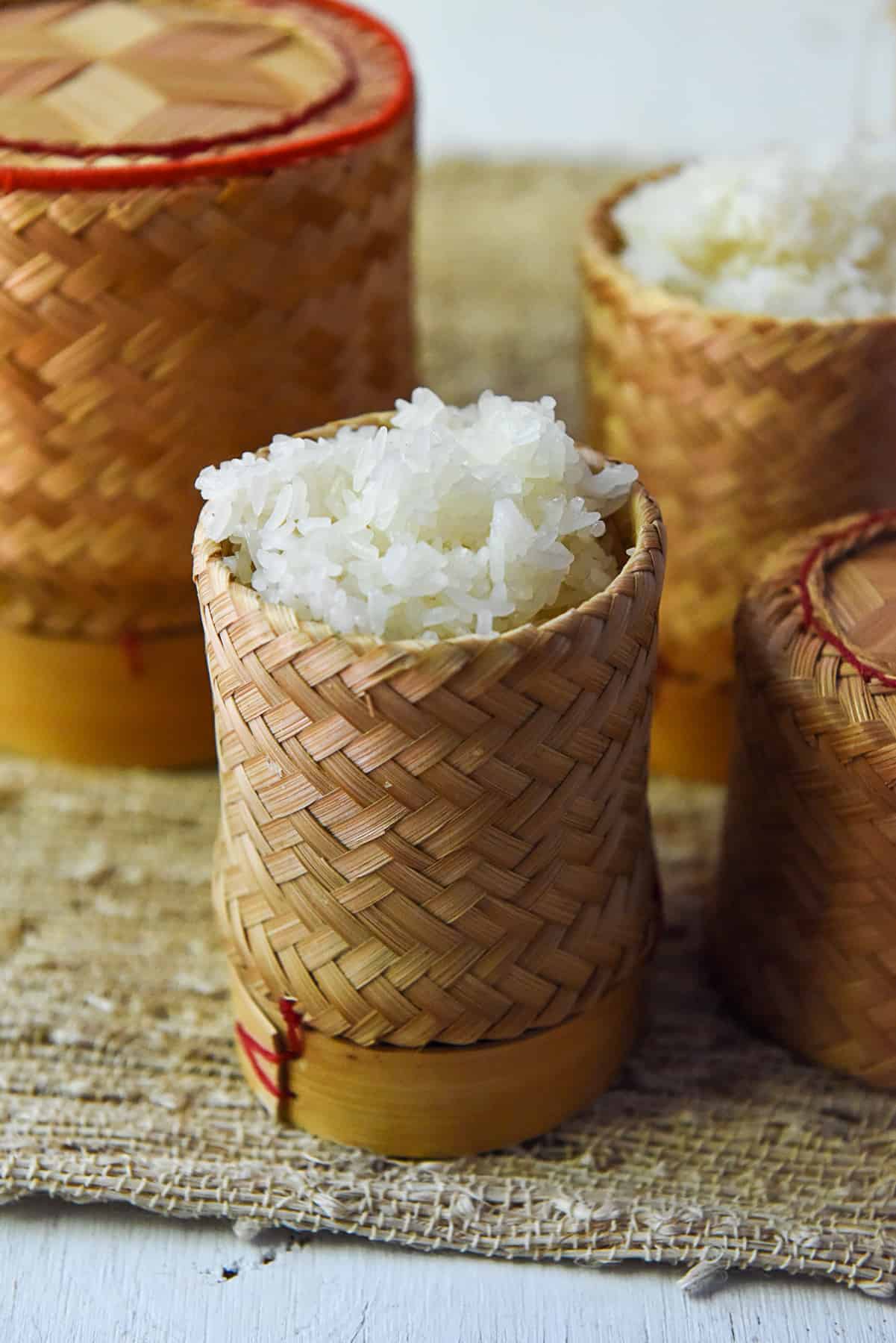
Although jasmine rice is the staple rice of Thai cuisine, sticky rice also plays an important role. It is the rice of choice in the Northern and Northeastern (Issan) parts of the country where it is eaten preferentially over jasmine rice. In fact, the majority of Thai dishes that originate in the North and Northeast are eaten with sticky rice. Throughout the country, sticky rice is also eaten in place of jasmine rice when paired with specific dishes.
Sticky rice is usually eaten with grilled meats, such as Thai pork skewers (moo ping) and Thai grilled chicken (gai yang). It is also often paired with green papaya salad (som tam) and some meat-based salads like larb and beef waterfall. And most famously, sticky rice forms the foundation of the popular Thai dessert, mango sticky rice.
Because of the unique characteristics of sticky rice, it cannot just be combined with water and cooked in a rice cooker or pot like jasmine rice can. Instead, Thai sticky rice is traditionally made by soaking the rice grains overnight, then steaming them in a special bamboo steamer. In this article I'll show you how to make sticky rice using this traditional Thai method.
Jump to:
Ingredients
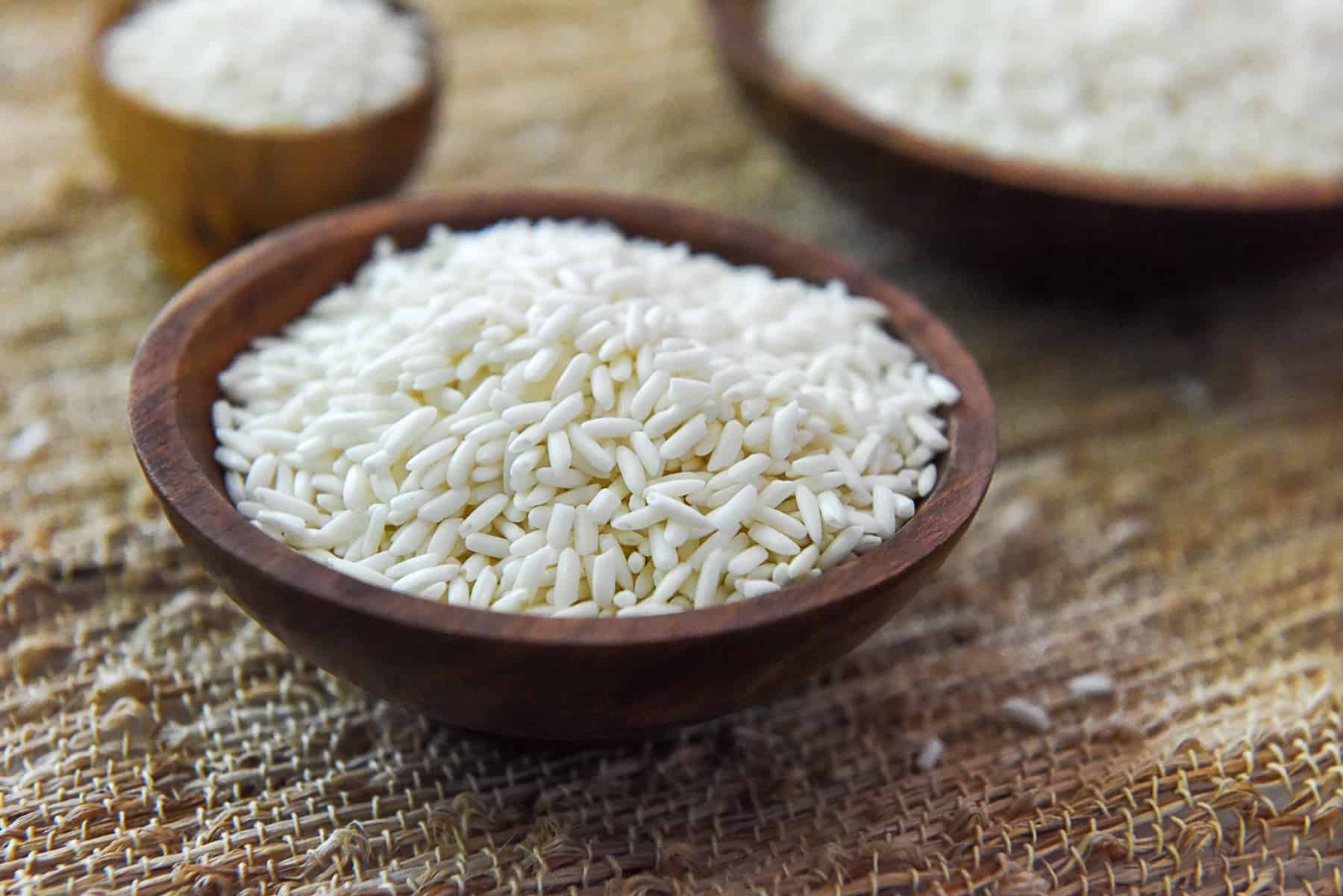
- Thai Sticky Rice: Thai sticky rice is a type of long grain rice with unique characteristics. It contains more amylopectin and less amylose than other varieties of rice. Amylopectin breaks down when cooked, so rice with higher percentages of this starch become sticky. Compared to jasmine rice, sticky rice is more white in color and only turns translucent once cooked. It is known as khao neow (ข้าวเหนียว) in Thai, which literally translates to "sticky rice". It can also be referred to as "sweet rice" or "glutinous rice". It is important to note that Thai sticky rice is not the same as the short grain sticky rice that's used in Chinese, Japanese, and Korean cooking. You can usually find Thai sticky rice at Asian grocery stores. But if it's not local to you, it can be purchased online.
- Water: Water is necessary for both soaking and cooking Thai sticky rice.
NOTE: For the context of this article, I am referring to white Thai sticky rice. Black sticky rice (Khao Neow Dam) also exists, which is sticky rice in its unpolished form. Black sticky rice is used mostly in Thai desserts, like this Mango with Black Sticky Rice.
Equipment
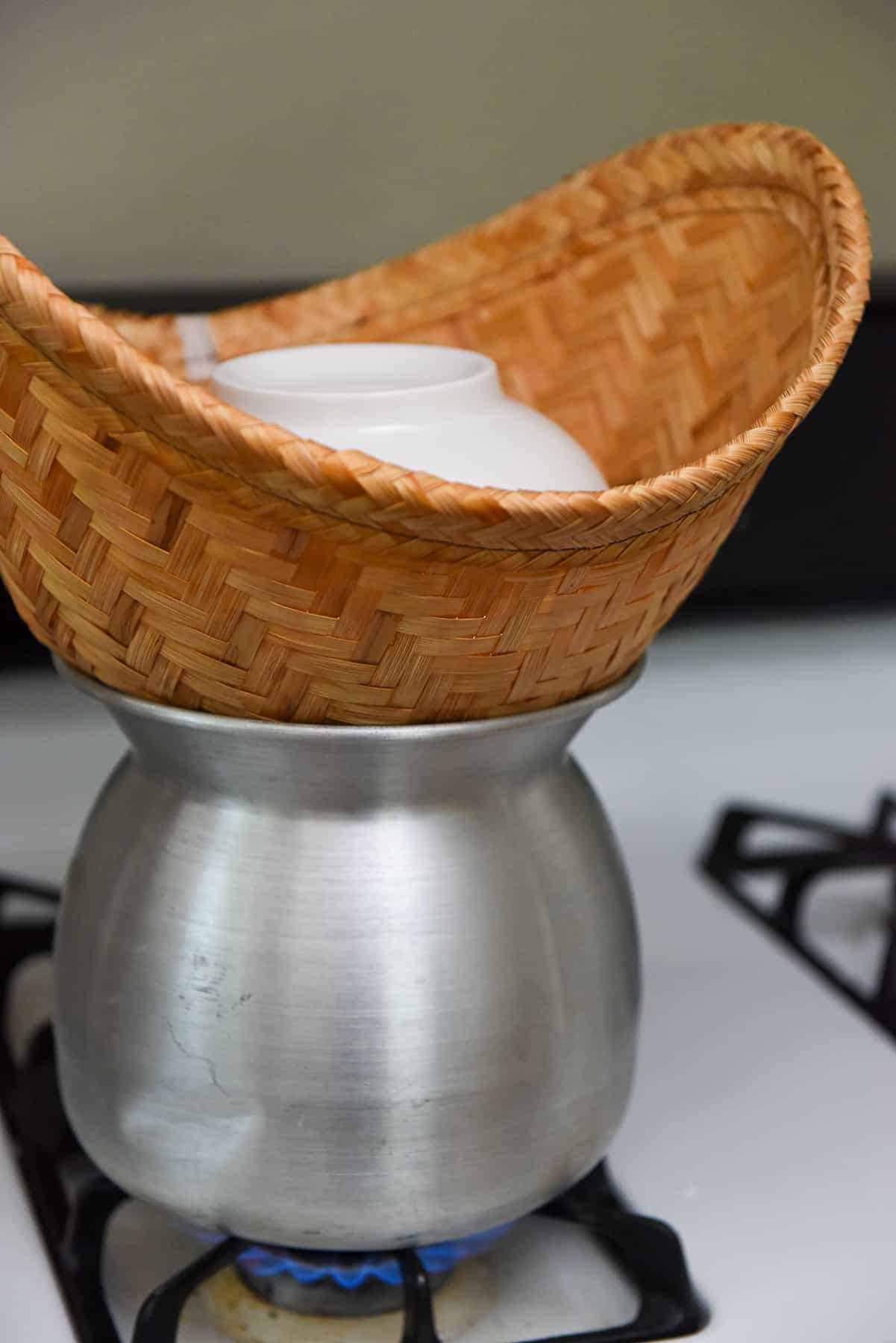
- Aluminum pot: This aluminum pot is the traditional pot used to heat water for steaming sticky rice. The bamboo steamer basket is made to sit on top of it. Because it's made of a thin aluminum, water heats up very quickly.
- Bamboo steamer basket: This steamer basket is made of woven bamboo, which imparts a pleasant aroma to the cooking rice. It's placed on top of the aluminum pot and holds the sticky rice while it steams.
- Cheesecloth: Cheesecloth is used to hold the sticky rice inside the steamer basket so that the grains of rice don't stick to the bamboo.
- Lid: A lid is necessary to put inside the steamer basket so that the steam stays inside to cook the rice. You can purchase a lid specifically made for the steamer basket, or you can improvise with a regular pot lid or ceramic bowl.
- Sticky rice serving basket: A woven bamboo sticky rice serving basket is nice to have, but certainly not necessary. These baskets are used to hold the sticky rice once it has been cooked and to keep it warm on the table during mealtimes.
There are also All in One Kits available for purchase online that contain all of the above items needed to make Thai sticky rice. A kit like this could make an awesome gift for someone interested in cooking Thai food at home 🙂
Instructions
The traditional Thai method of making sticky rice requires special equipment as noted above as well as advance preparation to soak the rice. These limitations aside, this method is very straightforward and easy. Just follow these simple steps:
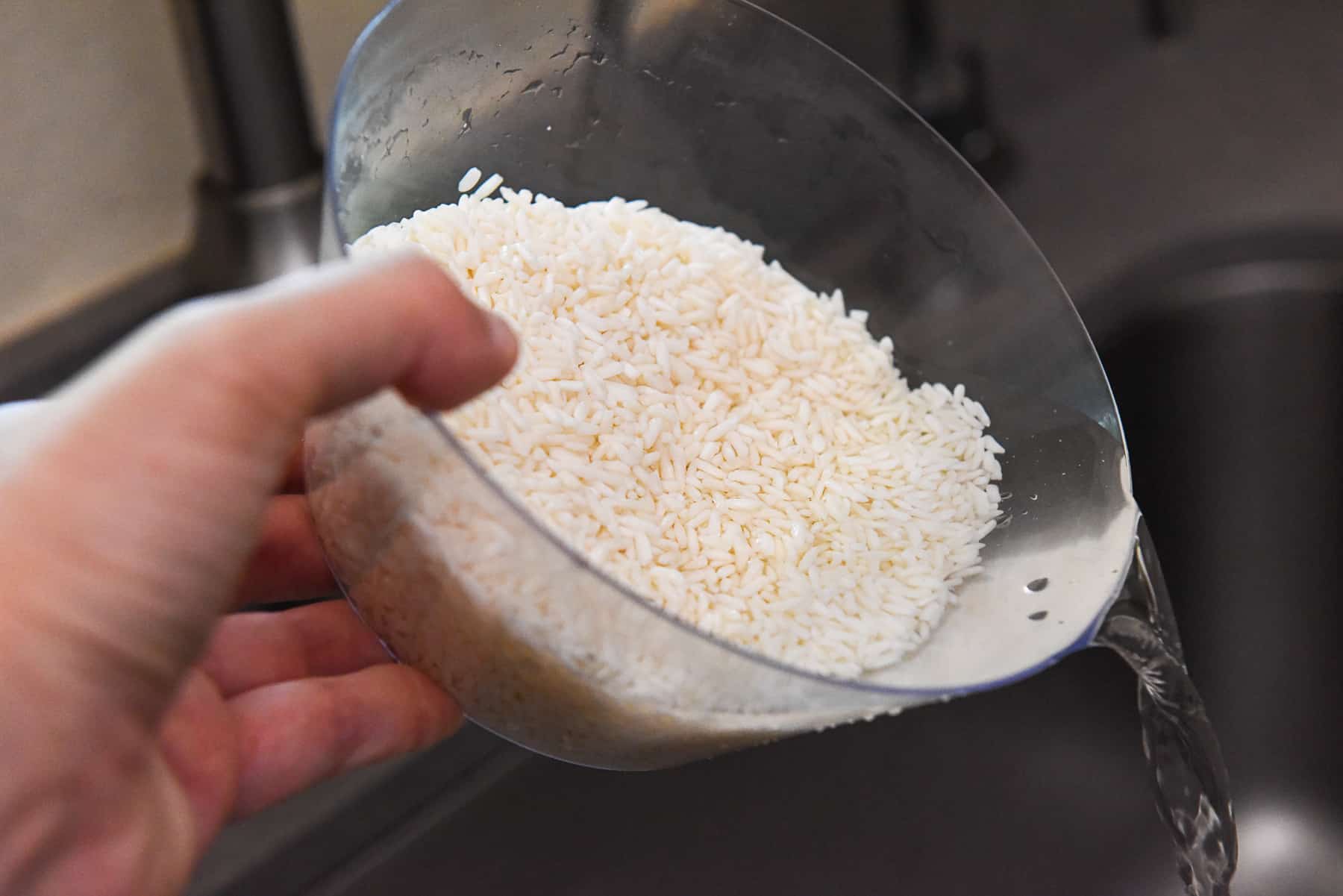
Rinse the sticky rice until the water runs clear. Add water until it's about an inch over the rice, then soak at room temperature for at least 4 hours and up to overnight.1
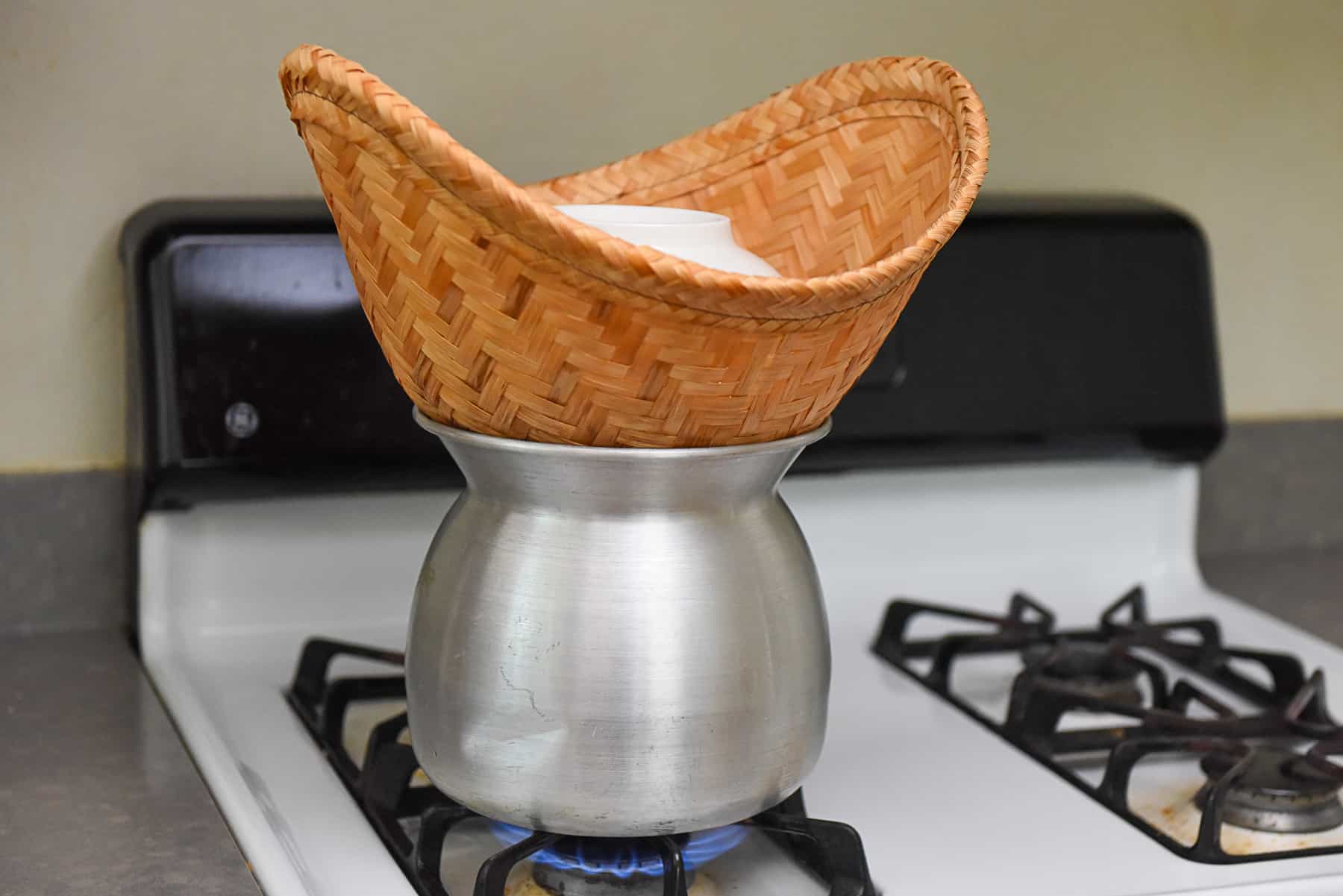
Fill the aluminum pot about halfway with water and bring to a boil.2 Run the bamboo steamer and cheesecloth under water until both are damp.3 Then place the bamboo steamer on the pot.
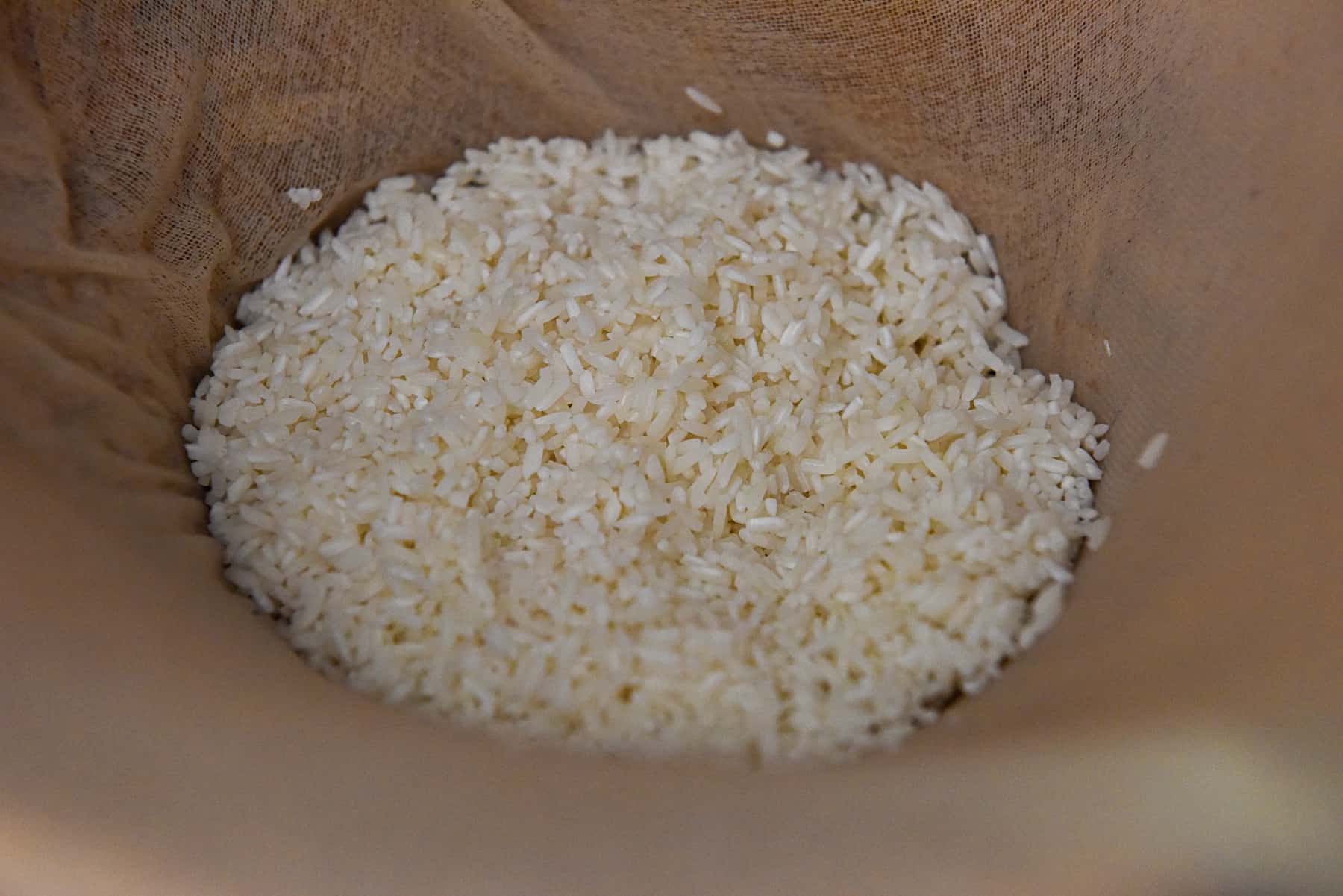
Pour the water off the soaked sticky rice. Place the rice into the damp cheesecloth and put both into the steamer basket. Cover the rice with a lid so that no steam escapes and cook for 40 minutes.4
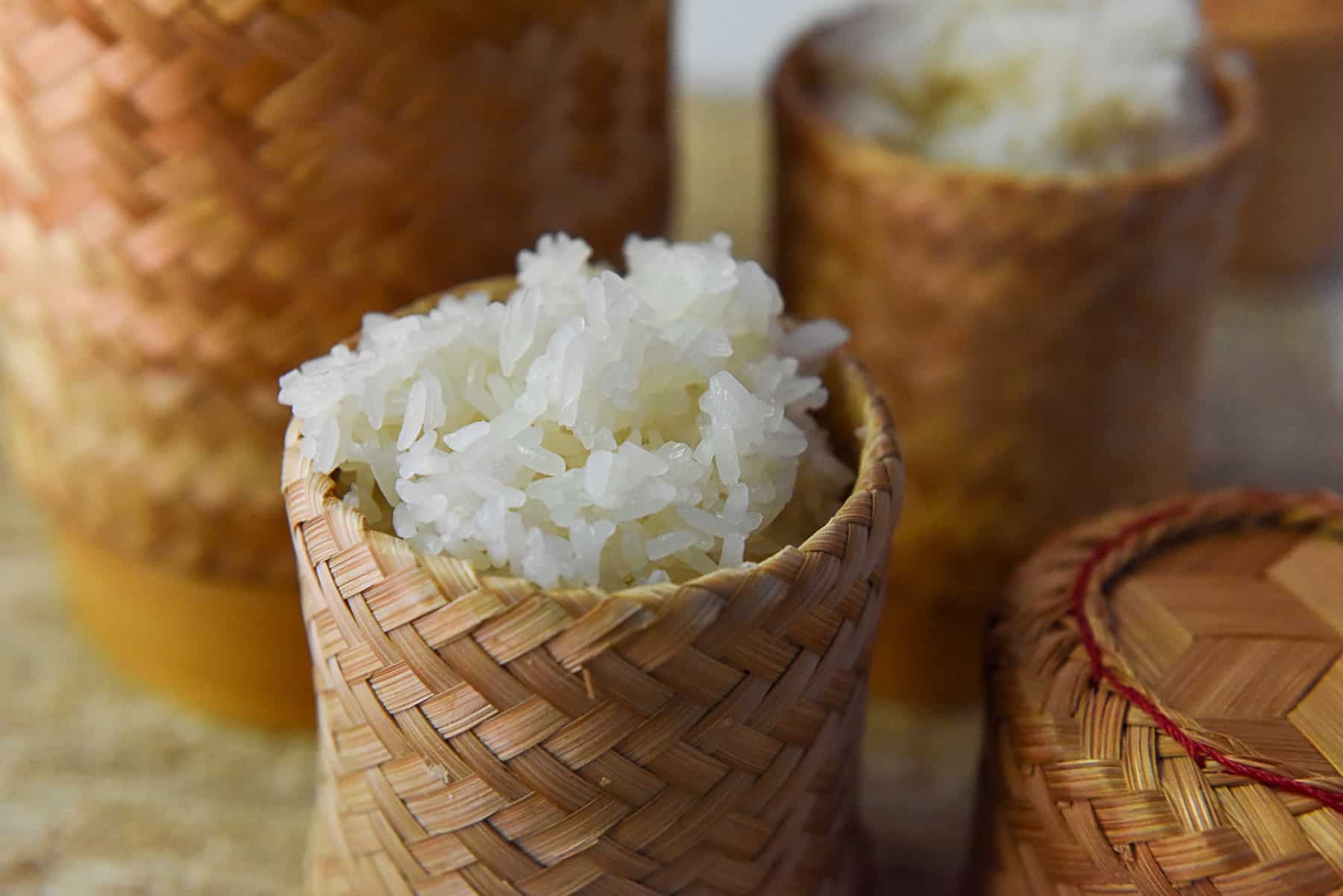
Check for doneness. The rice should be translucent (not white) and chewy (but not hard). Use a spoon to stir the rice, then transfer to a bamboo serving basket or serving plate.
NOTES:
- If the sticky rice is left soaking longer than overnight at room temperature, it will start to ferment. If you don't get around to steaming it after an overnight soak, it's best to throw it out and start again.
- The water in the aluminum pot should not touch the bamboo steamer basket.
- This prevents the bamboo and cloth from burning if flames from the stove/fire drift too far upward.
- You can flip the sticky rice about halfway through the steaming process, if you like. This can help to ensure that the rice on the bottom and top are both equally done.
How to Serve Thai Sticky Rice
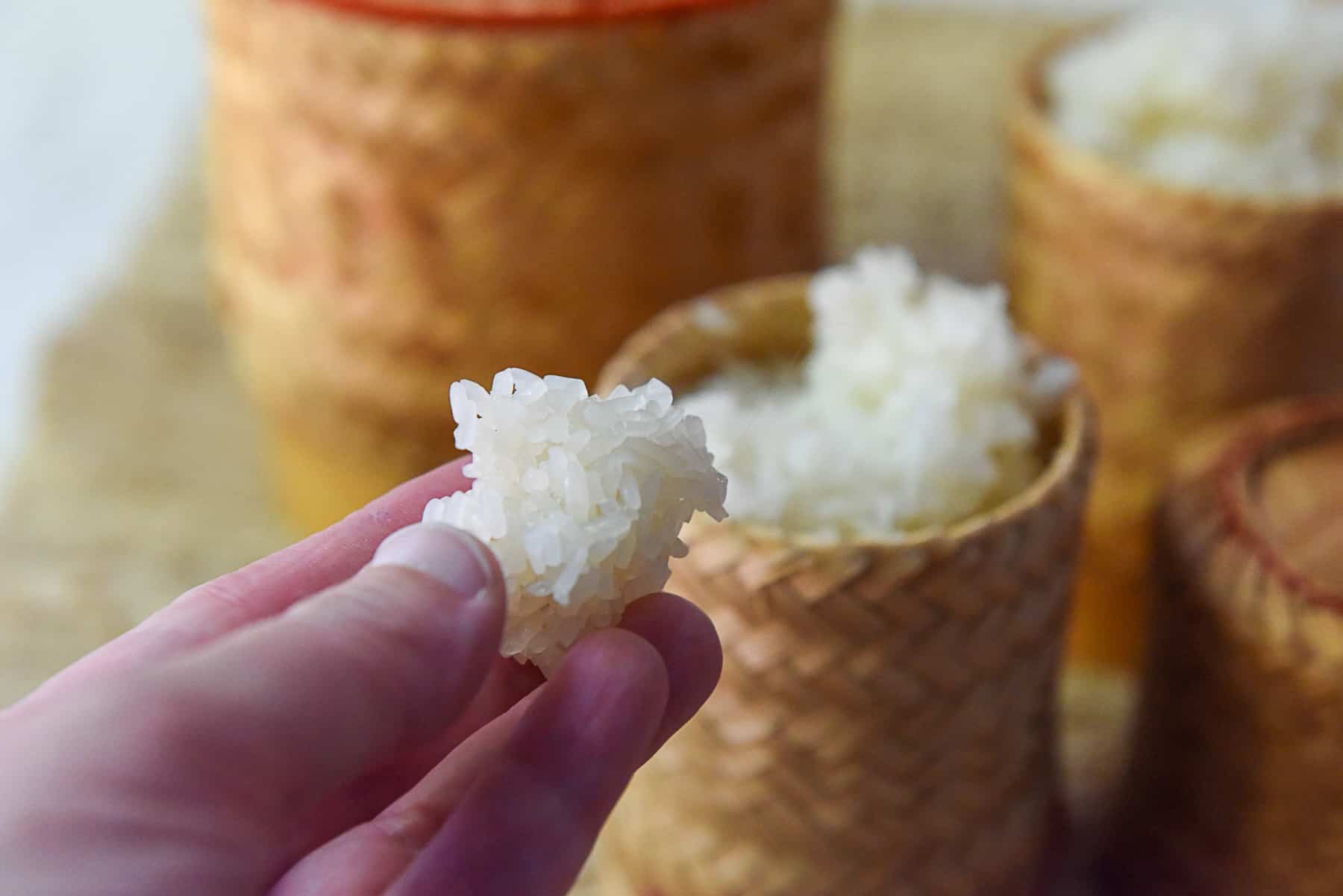
The sticky rice can be scooped directly from the bamboo steamer basket to your serving basket or plate. The bamboo sticky rice serving baskets are great because they have a top that helps keep the rice warm. If you're serving it on a plate, you could wrap the rice with saran wrap to help it stay moist while you're eating.
Sticky rice is most commonly eaten with your hands, not a spoon or fork. Grab a handful and roll it into a little ball. It can be dipped into Northern/Northeastern spicy dipping sauces or curries, or eaten in between bites of grilled meats and meat-based salads.
Here are some Thai dishes that are commonly eaten with sticky rice:
How to Store and Reheat Sticky Rice
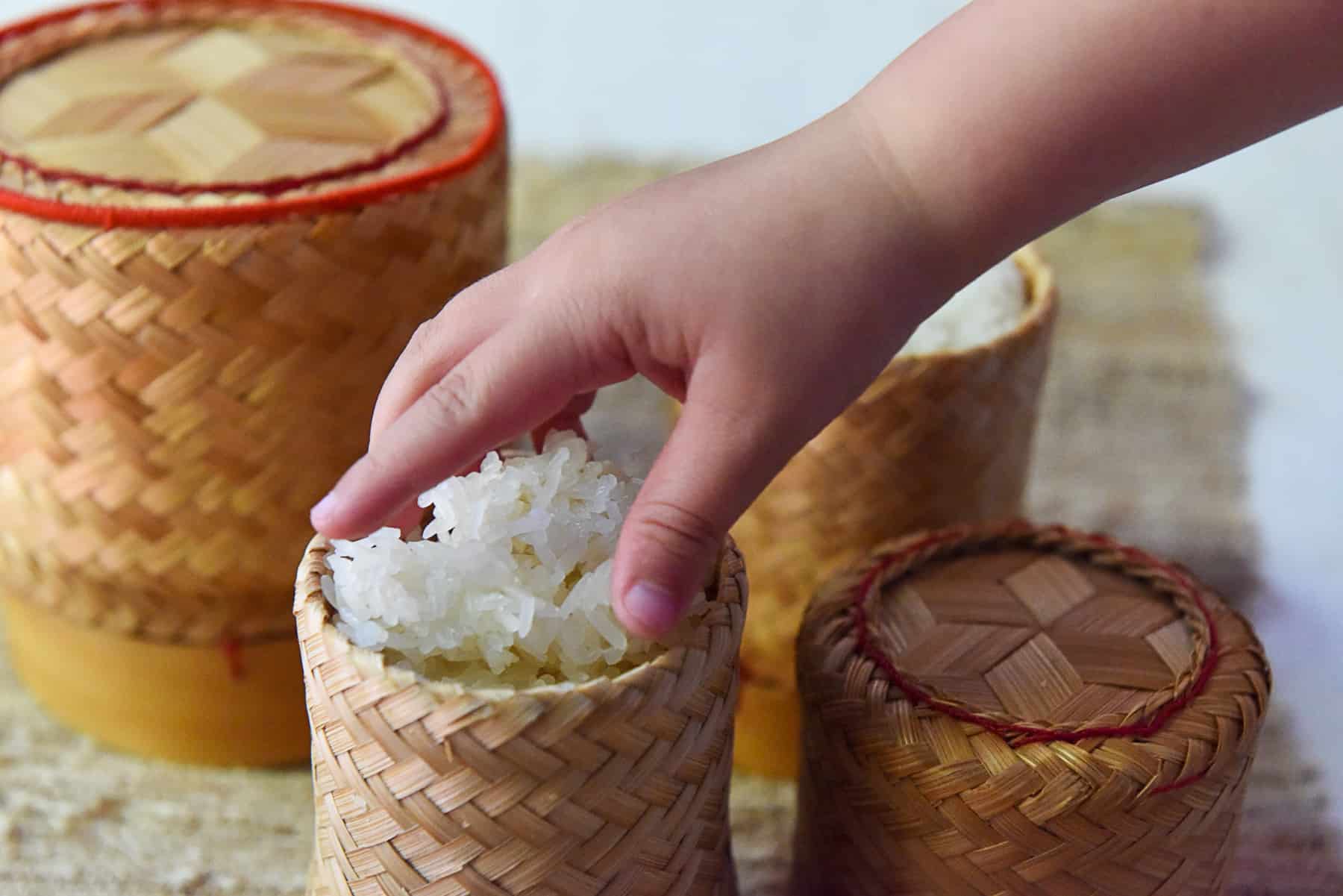
We don't often have leftover sticky rice :). However, if the sticky rice isn't finished in one sitting, it can be saved. Wrapped tightly in saran wrap, the sticky rice will last in the fridge for several days. To reheat, you can steam it again using the same method described above, although it will take less time (5-10 minutes should be enough). Alternatively, you can put the sticky rice on a place covered with a damp paper towel and microwave it for 1-2 minutes.
FAQ
To make Thai sticky rice, you need to start with the correct type of long-grain sticky rice. The rice is then soaked for at least 4 hours or up to overnight before being steamed in a special bamboo steamer basket.
Jasmine rice is the staple rice of Thai cuisine. Sticky rice is also eaten with certain dishes (grilled meats, som tam, meat-based salads) and in certain parts of the country (Northern and Northeastern Thailand).
There are some methods of making sticky rice that don't require soaking, or that cut the soaking time down by using boiling water to soak. However, these methods are not as fool proof as the traditional Thai method presented here.
Recipe

HOW TO: Make Thai Sticky Rice
Ingredients
- 1 cup Thai sticky rice
- 2 cups water
Instructions
- Add 1 cup of Thai sticky rice to a large bowl. Rinse with water until the water runs clear.
- Add water to the washed rice until it's approximately an inch above the rice (roughly 2 cups of water). Allow to soak at room temperature for at least 4 hours and up to overnight.1
- Fill the aluminum pot halfway with water and bringing it to a boil.2 Wet the bamboo steamer basket and cheesecloth.3 Pour the soaked rice into the cheesecloth and set it inside of the steamer basket. Place on top of the aluminum pot and put a lid on top of the rice so that no steam escapes. Allow to steam untouched for 40 minutes.4
- Check for doneness by sampling the sticky rice. It should be translucent (not white) and chewy (but not hard). If it is not quite done, continue steaming until the grains are perfectly soft and chewy. Once the sticky rice is done, take it out of the steamer basket and serve immediately.
Notes
- If the sticky rice is left soaking longer than overnight at room temperature, it will start to ferment. If you don't get around to steaming it after an overnight soak, it's best to throw it out and start again.
- The water in the aluminum pot should not touch the bamboo steamer basket.
- This prevents the bamboo and cloth from burning if flames from the stove/fire drift too far upward.
- You can flip the sticky rice about halfway through the steaming process, if you like. This can help to ensure that the rice on the bottom and top are both equally done.









Jessica
I used this to make mango sticky rice! Does it matter if I soak the rice over night covered or uncovered? Thank you for sharing this easy steps to follow! (:
Rachel
Glad it was helpful! I don't usually cover my rice as it soaks overnight, but I don't think it matters either way.